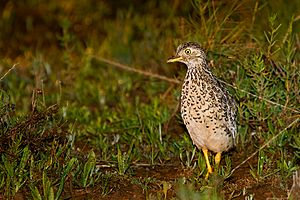Plains-wanderer facts for kids
Quick facts for kids Plains-wanderer |
|
|---|---|
 |
|
| Conservation status | |
| Scientific classification | |
| Genus: |
Pedionomus
|
| Species: |
torquatus
|
The plains-wanderer (Pedionomus torquatus) is a very special bird. It is the only member of its family, called Pedionomidae. This means it is very unique! This bird lives only in Australia. Most of the Plains-wanderers left in the world live in the Riverina region of New South Wales.
Contents
What Does the Plains-wanderer Look Like?
The Plains-wanderer is a small bird that lives on the ground. It looks a bit like a quail. It is about 15 to 19 centimeters long. This bird is so unusual that scientists have placed it in its own special family.
The male Plains-wanderer is light brown on its back. Its belly is a fawn-white color with black crescent shapes. The female Plains-wanderer is much bigger than the male. She has a clear black collar with white spots.
These birds are very good at hiding. Their colors help them blend in with the ground. If something bothers them, they will first try to hide. If you get too close, they will run away. They are not very good at flying.
Life Cycle and Reproduction
Female Plains-wanderers lay about four eggs. After the eggs are laid, the male bird takes care of them. He sits on the eggs to keep them warm until they hatch.
How Scientists Study the Plains-wanderer
For a long time, scientists were not sure how the Plains-wanderer was related to other birds. They used to think it was related to buttonquails or even cranes.
However, new studies using DNA have shown something different. Scientists now believe the Plains-wanderer is a type of wader. Waders are birds that usually live near water. This means the Plains-wanderer looks similar to other birds, but it is not closely related to them. This is called convergent evolution.
Why the Plains-wanderer Needs Our Help
The number of Plains-wanderers has gone down a lot. This is because their homes (native grasslands) have been turned into farms. Also, the fox, which was brought to Australia, hunts these birds.
Plains-wanderers build their nests on the ground. They are not good at flying and often run from danger. This makes them easy prey for foxes.
BirdLife International has found important places for Plains-wanderer protection. These places include:
- Boolcoomatta, Bindarrah and Kalkaroo Stations in South Australia.
- Diamantina and Astrebla Grasslands in Queensland.
- Patho Plains in Victoria.
- The Riverina Plains in New South Wales.
What Does "Critically Endangered" Mean?
The Plains-wanderer is listed as Critically Endangered on the 2018 IUCN Red List. This means it is facing a very high risk of disappearing forever.
In Australia, the Plains-wanderer is also listed as Critically Endangered under a law called the Environment Protection and Biodiversity Conservation Act 1999. Its status can also be different in each state:
- In Victoria, it is Critically Endangered.
- In New South Wales, it is Endangered.
Helping the Plains-wanderer Survive
To help these birds, a special breeding program started in late 2018. It is at the Taronga Western Plains Zoo in Dubbo. They built a special place with 30 aviaries (large bird enclosures).
The birds born here will form a "safety population." This means they will be kept safe in the zoo. Later, some of these birds will be released into the wild. This will help the wild population grow and survive.
See also
 In Spanish: Torillo australiano para niños
In Spanish: Torillo australiano para niños


